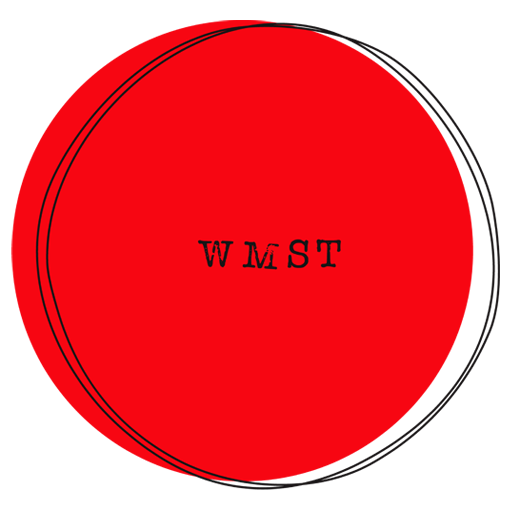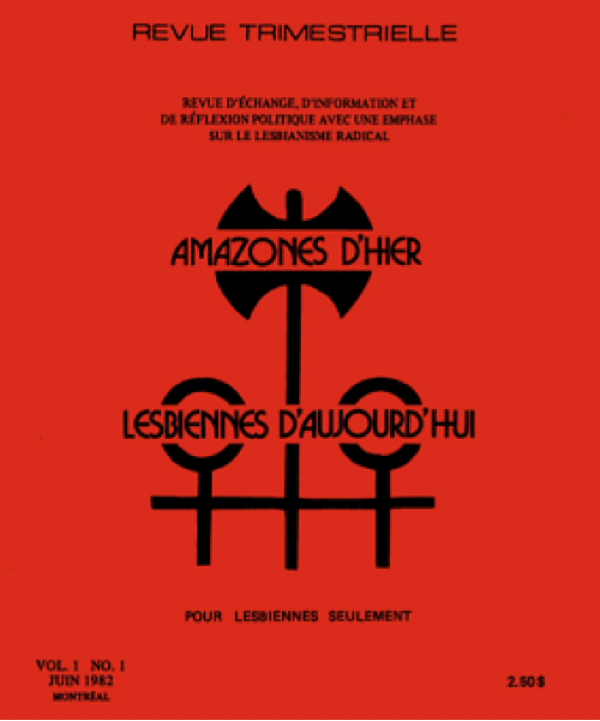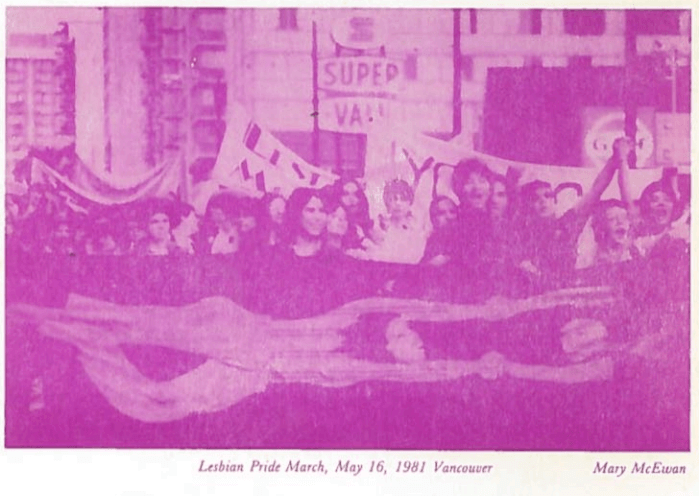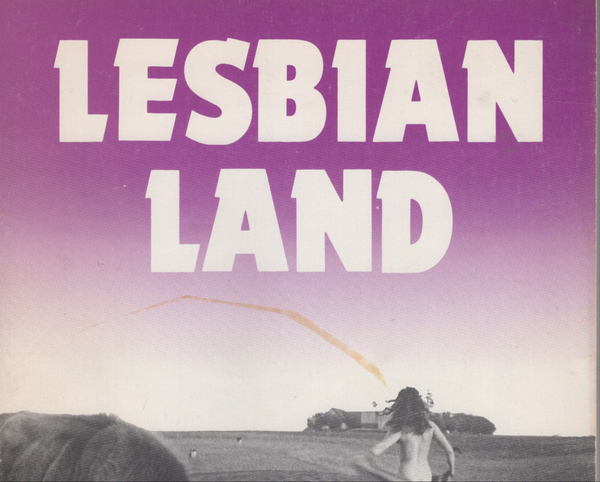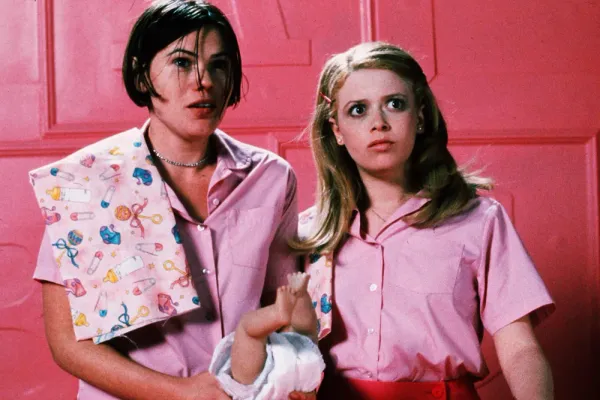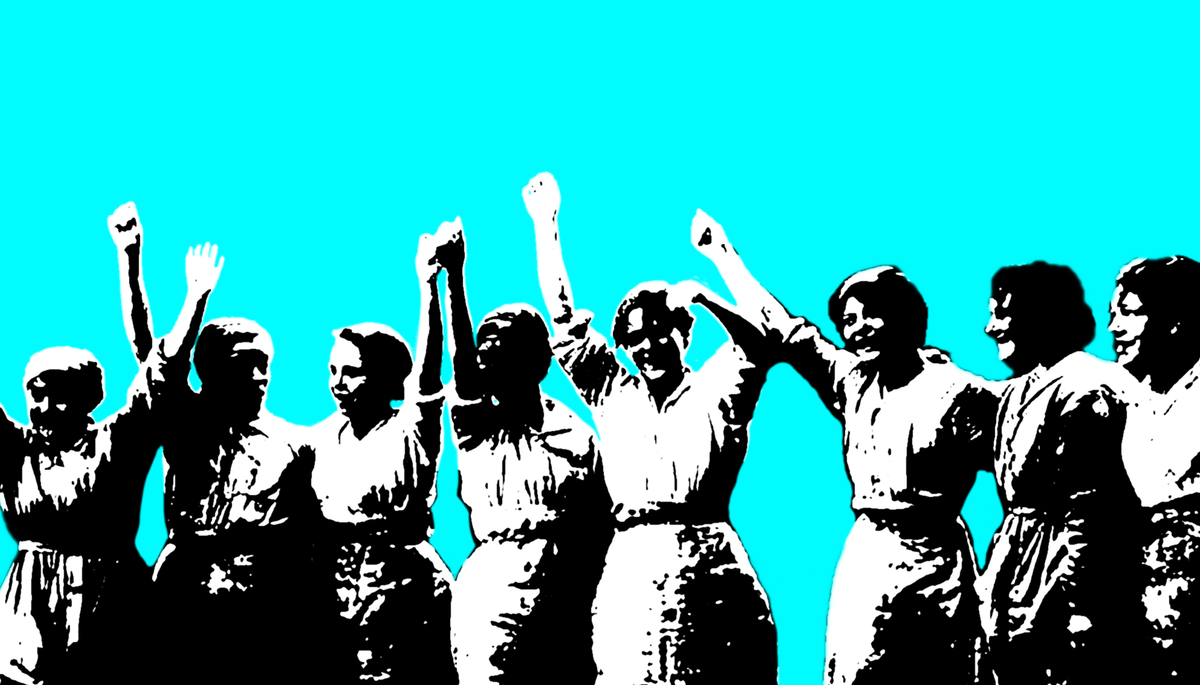Sapphic Circle is a space for lesbians to come together for thoughtful discussions on a variety of topics. We seek to build lesbian community through engaging in lesbian ideas, politics, media, and more!
What Is Separatism?
The Woman-Identified Woman by The Radicalesbians (1970) is one of the more well known texts that outlines the core concept of separatism: women reserving our resources, energy and relationships for each other, in an effort to overthrow the patriarchy and/or not collude with the male oppressor.
"That identity we have to develop with reference to ourselves, and not in relation to men. This consciousness is the revolutionary force from which all else will follow, for ours is an organic revolution. For this we must be available and supportive to one another, give our commitment and our love, give the emotional support necessary to sustain this movement. Our energies must flow toward our sisters, not backward toward our oppressors. As long as woman's liberation tries to free women without facing the basic heterosexual structure that binds us in one-to-one relationship with our oppressors, tremendous energies will continue to flow into trying to straighten up each particular relationship with a man... This obviously splits our energies and commitments, leaving us unable to be committed to the construction of the new patterns which will liberate us."
Who Were The Early Separatists?
Although there are some groups and writings that contained separatist ideals in the late 1960s, it started to spread and gain momentum in the 1970s. Several groups or collectives started publications that heavily discussed separatism, including the following:
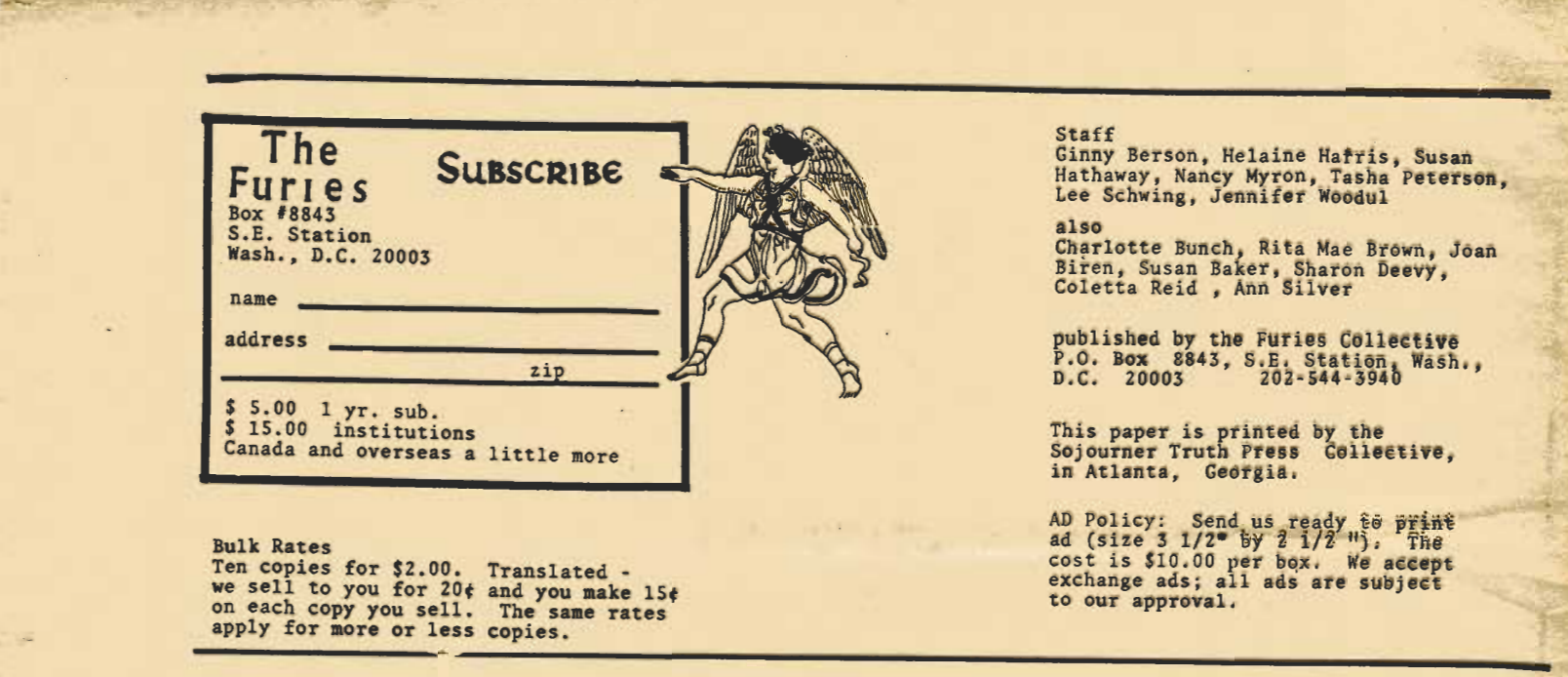
No More Fun and Games: A Journal of Female Liberation by Cell 16, 1968-1973, Boston, Massachusetts
The Furies Lesbian/Feminist Monthly by The Furies, 1972-1973, Washington, D.C.
Dykes and Gorgons by The Gutter Dykes Collective, 1973-1976, Berkeley, California
The Van Dykes, 1977-1979, a caravan of lesbian separatists that started near Toronto and traveled around the US and Mexico, primarily visiting womyn's lands and womyn's festivals (no publication but a notable group)
Amazones d'hier, lesbiennes d'auhourd'hui by the AHLA Collective, 1982-2014, Montreal, Québec
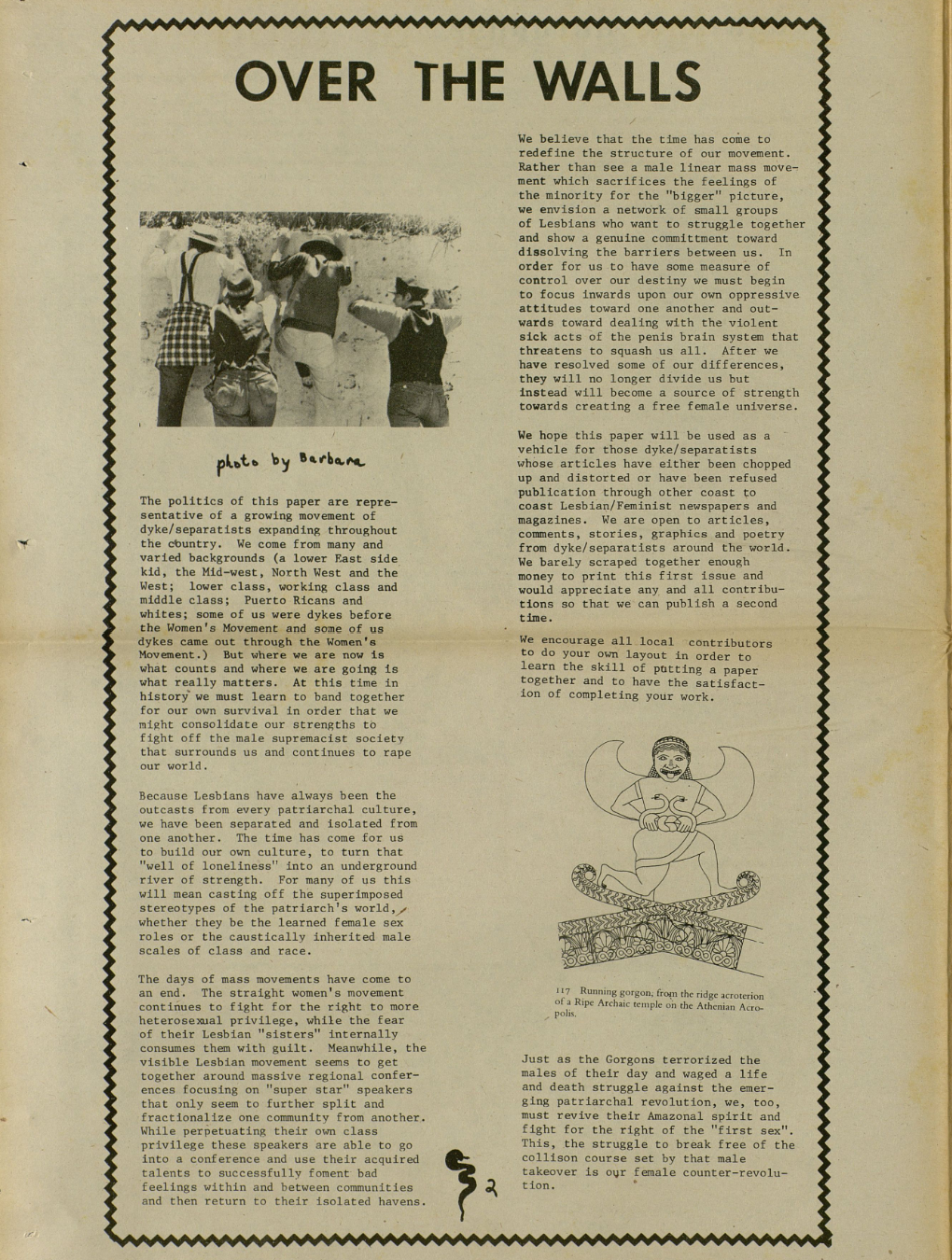
Separatism In Action
This excerpt from In Defense of Separatism, Chapter 3: Strategies, by Susan Hawthorne (2019) is a great explanation of the potential real world applications of separatism.
"Separatism is wide ranging in degree.
Separatism is an action, event or organisation that enables women to participate separately for political reasons. The last part is extremely important for without it tea parties and ladies’ auxiliaries would be included which are unlikely to play a role in the liberation of women. Moreover, those situations (tea parties, etc.) are unlikely to lead women changing their consciousness or lead to action which changes social structures.
Here are some of the manifestations of separatism varying in
degree:
1. Valuing dialogue with other women e.g. in consciousness-raising groups, study groups, or political action groups.
2. Engaging in political or social action with other women, e.g. abortion action groups, rape crisis groups, newsletter collectives.
3. Partaking in social gatherings in which only women participate, e.g. women’s dances. (Remember how women’s dances challenged ideas about what it was to have a good time—and that it was possible to do so without men around.)
4. Working in an environment which is run for and by women, e.g. women’s health centres, women’s publishing, unemployment centres for young women.
5. Becoming women-identified, giving emotional support to women, and involving oneself in sexual relations with women (and moreover, refusing to support men in any of the above ways), e.g. lesbian relationships or celibacy.
6. Participating in groups with other women that are concerned with creativity, e.g. theatre groups, writing workshops, art exhibitions, music groups.
7. Living in an all-women environment and having no contact with men. This is usually understood to be the standard separatist position, but is only possible for a limited number of women. Those for whom it is most feasible are women who live in all-women communities in the country. Many urban women limit their contact with men sufficiently to live a strongly separatist lifestyle. While only a few women will live this way, it is important to endorse as a strategy. It has inspirational value and is visible proof that women do not need men for social, financial and physical support.
8. Lesbian separatists might choose to not have contact with heterosexual women in one or more of the above areas.
The forms of separatism listed above need not occur in this order. It is not a hierarchical list whereby one measures one’s feminist commitment. It is important to recognise that separatism is a strategy engaged in by every feminist. It is a fundamental element of all feminist philosophy.
Separatism has come in for a lot of criticism both from within and without the women’s liberation movement. I believe it can withstand the criticisms that have been put forward and that it offers women a powerful political strategy (Hawthorne 1990)."
Other Notable Separatist Books/Authors
Lesbian Nation: The Feminist Solution by Jill Johnston (1973)
For Lesbians Only, Edited by Julia Penelope & Sarah Lucia Hoagland (1988)
Lesbian Ethics: Toward New Value by Sarah Lucia Hoagland (1988)
The Politics of Reality (1983) and Willful Virgin (1992) by Marylin Frye
Dykes Loving Dykes by Bev Jo and Linda Strega (1990)
The Lesbian Heresy by Sheila Jeffreys (1993)
Questions To Consider
- When did you first hear the word "separatism"? What did you think of it when you first came across it?
- In what ways do you think women are incidentally implementing separatism in their lives?
- How or where do you try to implement separatism into your life?
- How has the value and potential of separatism changed in the last 50 years?
References
Radicalesbians, The. (1970). The Woman-Identified Woman. [Manifesto]. Self Published.
https://drive.google.com/file/d/1OG11A9KI9NC52uU1wX9ztLtMHg1HrUbB/view?usp=sharing
Cell 16. (1968). No More Fun and Games: A Journal of Female Liberation. [Serial]. Self Published.
https://veteranfeministsofamerica.org/wp-content/uploads/2022/08/No-more-fun-and-games.pdf
The Furies. (January 1972). The Furies Lesbian/Feminist Monthly, Volume 1. [Serial]. Self Published.
https://archives.rainbowhistory.org/files/original/17bab37903adb25038027de56d5c88a7.pdf
The Gutter Dykes Collective. (May 1973). Dykes & Gorgons, Volume 1 Issue 1. [Serial]. Self Published.
https://www.jstor.org/stable/community.28035716?searchText=dykes+and+gorgons+1973&searchUri=%2Faction%2FdoBasicSearch%3FQuery%3Ddykes%2Band%2Bgorgons%2B1973%26scope%3DeyJpZCI6ICIxMDAwODYzNDciLCAicGFnZU5hbWUiOiAiSW5kZXBlbmRlbnQgVm9pY2VzIiwgInBhZ2VVcmwiOiAiL3NpdGUvcmV2ZWFsLWRpZ2l0YWwvaW5kZXBlbmRlbnQtdm9pY2VzLyIsICJ0eXBlIjogImNvbGxlY3Rpb24iLCAicG9ydGFsTmFtZSI6ICJSZXZlYWwgRGlnaXRhbCIsICJwb3J0YWxVcmwiOiAiL3NpdGUvcmV2ZWFsLWRpZ2l0YWwvIn0%253D%26so%3Drel&ab_segments=0%2Fbasic_search_gsv2%2Fcontrol&refreqid=fastly-default%3A8b370413fae0c6d08943597673867e45&seq=1
Amazones d'hier, lesbiennes d'auhourd'hui Collective. (1982-2014). Amazones d'hier, lesbiennes d'auhourd'hui. [Serial]. Self Published.
https://b1j.59f.myftpupload.com/revues-amazones-dhier-lesbiennes-daujourdhui/
Gargiolo, L. (Director). (2017). Lamar Van Dyke. [Film]. Outwards.
https://theoutwordsarchive.org/interview/lamar-van-dyke-2/
Hawthorn, Susan. (2019). In Defense of Separatism. Spinifex Press.
https://www.goodreads.com/book/show/50976991-in-defence-of-separatism
